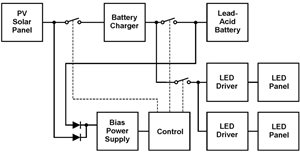Going green isn't always quite as simple as it seems; for example, take a system designed to store solar energy in a battery to power light-emitting diodes (LEDs) at night. As you can see from the block diagram (Figure 1), this system involves much more than just a battery and LEDs. The design can be broken up into multiple sub-functions, each requiring careful consideration at a system level. Let’s review these sub-functions.
Figure 1: Solar-powered LED lighting system
Control algorithm
Simply connecting the (50W/21V) solar panel across a 12-V battery (through a diode) sacrifices about 30 percent of the available solar energy to charge the battery. This is due to the current-voltage characteristics of solar cells. When the panel is lightly loaded, its output voltage remains high, only drooping slightly as the load on it increases. When loaded beyond its maximum output power, the panel’s voltage rapidly collapses.
It is desirable to continuously operate at the panel’s “knee,” thereby extracting the maximum power under all lighting conditions. This is known as maximum power-point tracking (MPPT), but can be difficult to achieve because it changes with solar intensity, temperature and changing environmental conditions. Many MPPT control algorithms exist, with the most effective requiring microprocessors.
A simple, less-accurate method simply loads the panel to 76 percent of its open circuit voltage to approximate MPPT. But with the total cost of using solar panels still high, microprocessor control is recommended, as wasting energy isn’t a good option.
Battery charger
Each battery technology requires an optimized charging strategy to maximize capacity and life. Lead-acid or absorption glass mat (AGM) batteries offer high capacity at a low cost per amp-hour compared to other chemistries. The charger must have circuitry to precisely measure the charging current, as this is part of the data necessary for MPPT. All available solar-panel current is stored in the battery until it reaches its maximum charge voltage, at which point trickle charging begins. The battery must be maintained at the proper float voltage, which should be adjusted with a negative temperature coefficient. This necessitates additional circuitry to monitor the battery’s temperature, or at minimum the ambient temperature. If not implemented correctly, overcharging is possible and damage to the battery may occur.
Bias supply
Whether you’re using a microprocessor or analog circuitry, you’ll probably need a bias supply to power everything. You can use the solar panel and/or the battery as the input source, but you’ll have to consider various topologies depending on the expected minimum and maximum input voltages. A single-ended primary-inductor converter (SEPIC) or synchronous buck converter would likely cover most situations. Avoid less-efficient converters such as traditional bucks and linear regulators. This is not a system where you should be wasting power.
LED driver
Finally, the LEDs get to burn all of the efficiently gathered power. But they should burn it efficiently! Since it’s likely that multiple LEDs will be involved, a boost converter is the topology of choice when operating from a 12V battery. LEDs are typically driven with a constant current, so you must configure the boost converter as a current regulator. This provides constant illumination, even as the battery voltage decreases.
Finally, control logic is necessary to determine what the system should be doing at all times. These states include bulk battery charge, trickle charge, battery overvoltage/undervoltage, solar-panel connect, LED on/off, battery temperature control, etc. All of these functions must work seamlessly together and must be designed as a whole.
If you are interested in the trade-offs and intricacies involved in a solar lighting system, additional detail can be found in: Power Supply Design Seminar SEM1900, topic No. 7, “Designing a Solar-Cell-Driven LED Outdoor Lighting System.”
